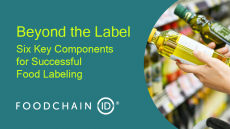AACC wants to clarify GI with new labeling
rate of carbohydrate absorption they trigger, is seeing increasing
interest from researchers and the food industry, but there is still
much confusion as to what it means. Philippa Nuttall reports
on how the American Association of Cereal Chemists is trying to
demystify it.
In an attempt to try and bring some clarity to the glycemic index question, the American Association of Cereal Chemists (AACC) has approved the formation of a committee to develop a science-based definition of glycemic carbohydrates.
The committee's aim is to provide a measurable definition that will enable manufacturers to communicate the glycemic response in grams per serving of food.
This information will hopefully help consumers better understand how the carbohydrate content of a given food will affect blood sugar levels.
At present, different approaches are used around the world. In the US, the amount of high glycemic (or net) carbohydrate is often calculated by subtracting low glycemic carbohydrate from total carbohydrate and the information is then displayed on food packages outside the nutrition facts panel.
"We need to take a scientific approach and also decide what is feasible," said Julie Jones, chair of the committee, which will hold its first conference call next week.
She told FoodNavigatorUSA.com that the committee, as it stands at the moment, is made up of a mixture of industry figures and academics from Europe and the States.
As to who the new labeling is aimed at, Jones said the committee had not yet "figured out a population per se", but suggested it could be useful for all people interested in a glycemic approach to their diet.
Moreover, she believes that health professionals as well as consumers need help to understand the reality of the glycemic index and thinks the labeling will be useful as it will take the focus away from an absolute number.
Jones explained that the problem with a single glycemic number is that it can change depending on which foods are eaten together.
"If I eat lentils at lunch - their glycemic number will change depending on what I eat for dinner," she said.
She added that different types of the same food can have different glycemic numbers.
"For example, Irish oatmeal, generally eaten in the UK, has a lower glycemic number than a traditional oatmeal that tends to be eaten in the US," she said.
She is sure that if the labeling is done correctly it will at least help "take some of the murkiness out of the subject."
As to whether the committee and the AACC would push to turn its labeling into legislation, Jones thought it was too early to say, but noted that the AACC's previous experience in this area helped to get a US health claim for oat bran.

















